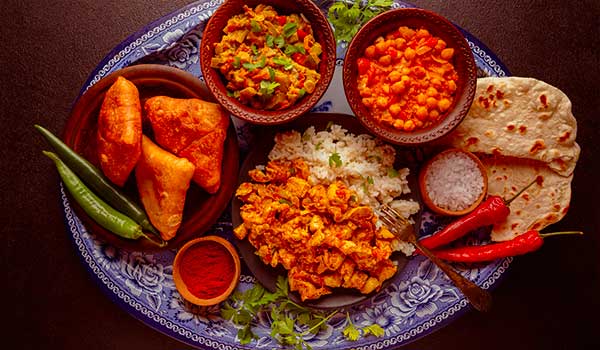
In India, you can find a wide range of spiciness levels in dishes. Some regions and specific dishes, such as those from Andhra Pradesh or Sikkim, are known for their spicy cuisine. Traditional Indian cuisine incorporates cooling and soothing elements alongside spicier dishes.
In many Indian households, children are introduced to spicy flavors at a young age, gradually building their tolerance. This early exposure and habituation to spice may result in a higher spice tolerance among some Indians.
Why is Indian food so spicy?
Indian cuisine is known for its diverse and bold flavors, including spices contributing to its spiciness. There are several reasons why Indian food tends to be spicy:
Cultural and Historical Factors
Spices have played a significant role in Indian culture and cuisine for thousands of years. India has a rich spice cultivation and trade history; spices were highly valued commodities. They were used not only for their flavor but also for their medicinal properties and preservation qualities. The tradition of using spices in Indian cooking has been passed down through generations, contributing to the development of complex and flavorful dishes.
Climate and Food Preservation
The hot and humid climate of India historically posed challenges for food preservation. With their antimicrobial properties, spices were used to preserve food and prevent spoilage. The use of spices, including chili peppers, helped combat the growth of bacteria and other microorganisms in the tropical climate.
Ayurvedic Influence
Ayurveda is a traditional Indian system of medicine that emphasizes the balance of body and mind. Spices are believed to have various health benefits in Ayurveda, including aiding digestion, boosting metabolism, and promoting overall well-being. Many Indian spices, such as turmeric, ginger, and cumin, are valued for their medicinal properties. Incorporating these spices into food is believed to provide health benefits.
Regional and Cultural Preferences
India is a diverse country with various regional cuisines, each with unique flavor profiles and spice preferences. Some regions, such as the Southern states of India, have spicier cuisine than others. Local ingredients and spices readily available in different regions have influenced the regional variations in spiciness.
Personal Taste and Customization
Indian cuisine offers a wide range of flavors and spice levels. While some dishes may be very spicy, others can be milder or non-spicy. The level of spiciness can be adjusted according to personal preference. Additionally, the use of yogurt-based sauces, such as raita, or other accompaniments like rice or bread, can help balance the spiciness of a dish.
Not all Indian food is overwhelmingly spicy. Indian cuisine encompasses various flavors. Numerous dishes are mild or have a balanced mix of spices. The spiciness of Indian food can vary depending on the specific dish, region, and individual preferences.
What is in Indian food that makes it so spicy?
Indian food gets its spiciness from various ingredients, mainly spices and chili peppers. Here are some common elements that contribute to the spiciness of Indian cuisine:
Chili Peppers: Chili peppers are a key ingredient in Indian cuisine and provide the characteristic heat. Various chili peppers used in Indian cooking include green chilies, red chilies, and dried chili powders like cayenne or Kashmiri chili. These peppers contain capsaicin, which stimulates the heat receptors in our taste buds, creating a spicy sensation.
Garam Masala: Garam masala is a blend of spices commonly used in Indian cooking. The exact combination of spices can vary, but it typically includes cinnamon, cloves, cardamom, cumin, coriander, and black pepper. Some garam masala blends may consist of dried chili peppers, further enhancing the dish’s spiciness.
Red Chili Powder: Ground red chili powder, made from dried chili peppers, is a staple of Indian cuisine. It adds heat and color to various dishes, such as curries, marinades, and spice rubs. The spiciness level of the chili powder can vary depending on the type of chili pepper used and the processing method.
Mustard Seeds: Mustard seeds are used in Indian cooking, especially in tempering or tadka, which involves frying spices in oil or ghee to release their flavors. Mustard seeds can provide mild to moderate spiciness, depending on the variety.
Black Pepper: Black pepper is another spice commonly used in Indian cuisine. It has a mild spiciness and adds a warm and peppery flavor to dishes. Black pepper is freshly ground, added to recipes, or used as a finishing touch.
Other Spices: Various other spices contribute to the overall spiciness and flavor complexity of Indian dishes. These include turmeric, cumin, fenugreek, cloves, cinnamon, and ginger. Each spice brings its unique flavor profile and, in combination, can create a harmonious balance of heat and aromatic notes.
Indian dishes are inherently spicy. The level of spiciness can be adjusted according to personal preference, and many Indian recipes can be modified to suit individual taste preferences, whether mild, medium, or fiery hot.
Learn more:
Why Do Mexicans Like Spicy Food?
Why Is Spicy Food So Addictive?
Why Does Milk Help With Spicy Food?
Table of Contents

